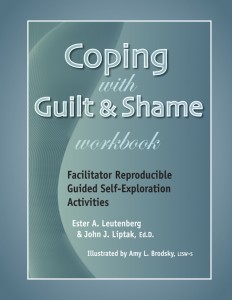Guilt or Shame – Are they the same?
Taken from Coping with Guilt & Shame Workbook by Ester A. Leutenberg and John J. Liptak, EdD.
Guilt, a very common type of emotional distress, can be described as a feeling that involves self-blame and a sense of responsibility for a regretted action, in-action, or thought. People experience guilty feelings with regret and self-reproach over the belief that they have done, or will do, something wrong or inadequately. Guilt often results from the perception of falling short of self-expectations or the expectations of others. Like many feelings, guilt is often based on irrational thoughts, not facts.
- Feelings of guilt are usually associated with self-talk statements such as “I should have,” “If I would have,” and “I could have.”
- Guilt can be a feeling people experience when they do something judged by their moral code to be wrong. This self-awareness is healthy and promotes self-reflection and positive growth. A person’s moral code, the differentiation of intentions, decisions, and actions between those that are good (or right) and those that are bad (or wrong) is so strong that feelings of guilt can occur when the person has an urge or thinks about doing something against it.
- Guilt can be both healthy an unhealthy. Healthy guilt keeps people functioning in socially acceptable ways and is often associated with a conscience or moral code. Unhealthy guilt occurs when people establish unreasonably high standards for themselves and then feel guilty when they are unable to maintain these standards or when they perseverate on little things that don’t meet their personal standard.
- Two distinctive forms of guilt exist: perceived guilt and justified guilt. Perceived guilt is when a person feels guilty even though he/she had no or little control over something that happened, or when a person negatively interprets the consequences of his/her actions. On the other hand, justified guilt emerges when the facts of a situation justify the person’s feelings of regret and guilt.
Shame is a basic part of being human. Shame can be described as a sense of inadequacy about who you are, how you behave and what you value. It is a negative emotion that people experience when they are feeling embarrassed, humiliated or disgraced, especially in the eyes of important people in their life. Shame is based on an image that people internalize of what is expected of them by others, or of themselves, and then the perception that they have fallen short in another’s, or their own, eyes. Shame can be incapacitating and injurious to people’s physical and emotional health, self-esteem and well-being.
- People experiencing shame will tend to hide or avoid others in order to lessen the damage of their image in the eyes of other people.
- Shame tends to be born of fears and drives people to want to hide or protect themselves from feeling or appearing inadequate.
- When shamed, people feel alone and outside of the rest of society. If shame is acknowledged, accepted and dealt with, it can be overcome.
- Two distinct forms of shame are inadequacy and self-disapproval.
Shame can also be experience when people feel embarrassed, inadequate, defective, contemptible or dishonorable. Self-disapproval shame occurs when people have painful feelings about themselves because of things they have thought or done.
Many people spend a great deal of their lives living with guilt and shame. It is important for them to deal with the emotions, thoughts and actions related to both guilt and shame in order to lead a more stress-free, calm and satisfying life.

